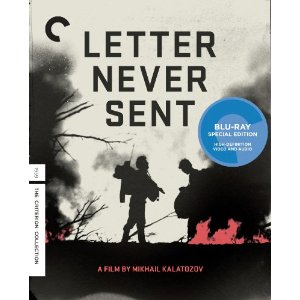Home Video Hovel- Letter Never Sent
Soviet director Mikhail Kalatozov isn’t exactly a household name, even by the standards of mid-century Soviet directors, but based on the strength of three films he made with cinematographer Sergei Urusevsky, he really, really should be. In many ways he’s the direct descendant of Sergei Eisenstein – a brilliant visual director in service of classic Soviet themes – and just as powerful a filmmaker. The Cranes Are Flying was among the first Soviet films to tackle the hardship of World War II, and I Am Cuba is a dizzying stylistic experience that has spawned a thousand sons (not to mention its exuberant political undertones). In between those two, Kalatozov and Urusevsky made Letter Never Sent, a simpler film than the other two from a story perspective, but one just as aesthetically ambitious.
In the rush to condemn the handheld camerawork of the modern era, it can be easy to forget just how truly free cinema can be when utilizing it. When one moves past the sub-Greengrass hacks and remembers not only Greengrass but Terrence Malick, who hasn’t had much use for a tripod in decades, one starts to remember the impetus that led so many filmmmakers to abandon their apparatus in favor of the experiential. But Kalatozov’s camera carries a different energy, one normally attributed to the hummingbird or a dandelion seed that has taken flight. His camera seems to explode out of his hand and burst through the forest, across a field, through a thicket, lost in the dizzying elation of victory or anticipation of oncoming defeat. He has a pretty strong text to back him up, but in the realm of pure cinema, it doesn’t come much purer than Kalatozov.
Following a diamond expedition that would free Russia of foreign merchants, Letter Never Sent is chiefly concerned with pitting one’s personal needs and wants against those of the country, and how the struggle for survival becomes a much grander task when your country is depending on you. Its Communist ideals become much more explicit the further the film moves forward – in a hallucination, one character envisions massive factories that would be erected should his quest be successful – but by always keeping these visions on a character level, he ensures that even those whose sympathies are not automatically aligned with his will remain engaged. That the story is driven more directly by romantic, even sexual, intrigue and a ripping survival yarn on par with Joe Carnahan’s recent film The Grey makes the experience go down smooth. It may have competed for the Palme d’Or, but this is art house cinema that entertains as it enlightens.
This disc is released as part of The Criterion Collection’s recent – and commendable – program of putting out DVDs and Blu-rays without any special features at reduced prices. While it’s always nice to get a big edition full of extras, these slim versions make a blind buy all the more attractive, and gets films like these the expensive, detailed transfers they deserve without worrying if a big price point would put off buyers. And wow, is Letter Never Sent a doozy of a Blu-ray. Some reviewers have called it the best black-and-white transfer ever, and while I wouldn’t go that far, it’s deserving of that kind of massive praise. With the way the camera moves, it would be so easy for it to succumb to ghosting and compression issues, but every crazy, glorious shot is there for the studying, crystal-clear and exhibiting tremendous depth. While this does have the unfortunate effect of revealing some production limitations – some scenes were shot on soundstages rather than locations, and are more obvious in high-definition than they might be otherwise – the total effect on the film is incalculable. Grain is lightly evident, but the geniuses at Criterion need not rely on that to give it a film-like apperance, which this absolutely is. Full of astounding compositions, a color palette than seems to extend the limitations of black-and-white photography, and camera movements you’re unlikely to find anywhere else, Letter Never Sent is the kind of film Blu-rays are built for; no other home video format could hope to do it justice.
Beyond that, we do get one extra – an essay by film schol Dina Iordanova, who uses the film’s cinematography as a springboard of discussing its history and themes. It’s the kind of all-purpose essay Criterion tends to commission, but which are so vital to each release. It’s a great read.
I couldn’t be more pleased with this Blu-ray release. Not only do we get a truly great piece of filmmaking at a very reasonable price, but we get it in the best quality possible. The other benefit of these barnbones discs is that no space is taken up with special features – every bit of data on this thing goes towards the film. And it really shows.




























Can’t wait to see this. Been too long since I’ve watched I Am Cuba. Didn’t quite work for me or mean anything when I saw it, but the older I get, the more I think I really missed something.
What would be the best B&W transfer ever?
Oh, man, that’s a tough one, even given that I don’t have nearly comprehensive knowledge on the subject. Last Year at Marienbad and The Third Man (Criterion, not Studio Canal) would be at the top of my list though, closely followed by almost any of Kino’s Buster Keaton releases (especially Steamboat Bill, Jr.) and Masters of Cinema’s City Girl.